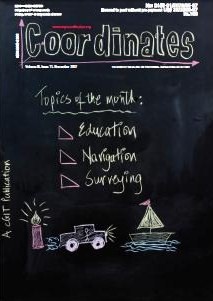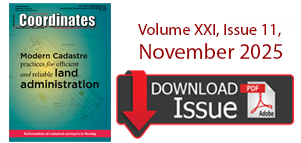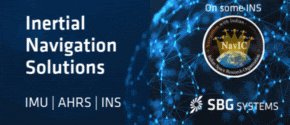A report of the first meeting in Bangalore, 4 September 2007
The International Committee on Global Navigation Satellite Systems (ICG) met in Bangalore, India, from 4 to 7 September, 2007, to review and discuss Global Navigation Satellite Systems (GNSS) and their promising applications. The ICG addressed the use of the applications to promote the enhancement of …

Volume III, Issue 11, November 2007
Zip
GNSS education in Asia Pacific: Miles to go
Azmi Hassan, Mustafa Din Subari
Precision Agriculture
Abdul Rashid Mohamed Shariff, Ebrahim Jahanshiri
Breaking distance barriers
Shunji Murai
India-Pakistan maritime boundary: Issues and approach
Rear Admiral K R Srinivasan
What is Extended Particle Filter?
Priyanka Aggarwal, Naser El-Sheimy
My Coordinates
EDITORIAL
His Coordinates
DATO’ DR ABDUL KADIR BIN TAIB
News
INDUSTRY | LBS | …

Rear Admiral K R Srinivasan
Rear Admiral K R Srinivasan
AVSM, IN (Retd), Hydrographic and Oceanographic Expert,
Chief Hydrographer, Government of India
MARITIME Boundary Delineation (MBD) with neighbouring States is an essential need for national security and offshore development, more so for developing States with sizeable Exclusive Economic Zone(EEZ) and Continental Shelf Areas. Whilst it is laudable that India …

JAPAN International Coorperation Agency (JICA) initiated RS course once a year since 1978FY with full sponsorship to invite 10-15 trainees per year from developing countries. JICA expanded to mapping & surveying, hydrographic survey, GIS etc. However JICA has changed the policy to introduce partially e-learning system in 2004 to improve the cost-efficiency. The reason is that the cost to invite a person from a developing country used to be 10,000 US dollars per month in average. JICA plans to expand JICA NET, a telephone-line based communication system to about 30 developing countries to enable TV conferences between Japan and developing countries.

UNIVERSITI Putra Malaysia (UPM) formerly known as Universiti Pertanian Malaysia was founded in 1971 through the merger of Faculty of Agriculture, University Malaya and Agriculture College in Serdang, State of Selangor. Since then UPM has evolved to become one of the leading universities in agriculture and science in Malaysia.

Azmi Hassan, Mustafa Din Subari
With our universities and numerous polytechnics offering Geomatic program, more is expected from them
Azmi Hassan
Center for Technology Policy & International Studies,
Universiti Teknologi Malaysia,Malaysia
Mustafa Din Subari
Center for Technology Policy & International Studies,
Universiti Teknologi Malaysia,Malaysia
THERE seems to be numerous GNSS education and training programs around locally, with government’s institutions and agencies taking the …
The European Parliament has voted to boost funding for the European Institute of Technology (EIT) and Galileo, the European satellite navigation system, at its first reading vote on the draft budget for 2008. The MEPs voted to reverse over €1.5 billion of cuts made by the Council to payments under the headings 1a (competitiveness, growth, employment) and 1b (cohesion).
A company called Satski has launched GPS navigation system for skiers giving an interactive map of the mountain that will guide, assist and record movements. The system will constantly update the current position on the map, give statistics and record coordinates, altitude, speed, and distance.
Vodafone, has introduced two of its Blackberry models, Curve 8310 and 8820 in India, recently. Curve 8310 is RIM’s latest innovation for customers who demand a featurerich multimedia and GPS-enabled smartphone.











 (5.00 out of 5)
(5.00 out of 5)